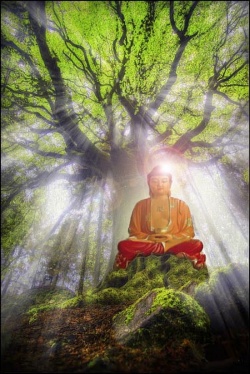Old Zen and Zazen
(This article appeared in the July 96 issue of the The Zennist newsletter.)
The history of Zen can be said to have begun in the Chinese port city of Canton some time around 480 A.D. with the arrival of a mysterious Indian Buddhist teacher, named Bodhidharma. Important to the background of Zen, there is nothing unique in the use of the term Zen (meditation) which would suggest that Bodhidharma was the sole originator of Zen. Judging from Buddhist documents of the Sui period, Zen, as a meditational practice, existed in China prior to Bodhidharma's arrival.
Still, Bodhidharma's introduction of what today is referred to as "Zen" to China is unique, but not because it is solely the practice of seated meditation. During the period of Bodhidharma's arrival, China was being flooded with many Buddhist scriptures from India.
Against this backdrop, Chinese Buddhists were bewildered as to how to interpret these scriptures correctly, often having to rely on their native religions for clues. With the advent of Bodhidharma's Zen came the message of the true teaching which revealed the keys for decoding the metaphorical language of the Buddhist scriptures.
Further, with Zen's arrival also came the message that the authentic teaching of the Buddha was really about Mind which could only be comprehended by a supreme act of noetic intuition, raising thought to the same level as the Buddha did when he uncovered his universal vision under the Tree of Knowing.
Bodhidharma's new message of Zen held that the Buddhist scriptures were not to be understood in a literal fashion. What, in fact, the scriptures pointed to was beyond the pale of the dead letter; this being the noumenal side of Buddhism which could only be transmitted from Buddha Mind to Buddha Mind by means of a special intuitional transference. During this transference, using the analogy of one torch lighting another, the Zen adept awakened suddenly to the very same Mind that the Buddha had awakened to long ago. Truth in this sense was imparted from the Buddha directly to the adept in which the Buddhist scriptures, subsequently, were regarded like a finger pointing to the moon.
Following the methodology of Bodhidharma's Zen, the early Zen practitioners sought thus to merge into the inner recesses of highest reality, namely, Buddha Mind. Like their founder, Bodhidharma, traditional Zennists practiced a form of contemplation known as "wall-gazing" which means "to abide in the pure silence of truth having transcended discrimination".
But rather than being a form of conventional meditation (J. zen; S. dhyana), Bodhidharma's "wall-gazing" is completely contemplative, drawing its strength from, and having its source directly in Buddha Mind itself.
Zen, unlike other Buddhist schools, has always claimed that it represents the true spirit of primitive Buddhism and therefore, the authentic teaching of the founder. Generally speaking, this claim seems substantiated by the facts, at least when we compare the very first Zennists with the Buddha's first horde of students. Indeed, both can be said to have placed a great deal of emphasis on meditation, contemplation, and self-discipline.
In addition, like primitive Buddhism, Zen steers away from the extensive use of rituals. As proof, Bodhidharma's writings show a positive disdain for such superstitious rubbish as washing a Buddha statue, which among other such practices, was prevalent in Chinese Buddhism during his stay in China.
To be sure, traditional Zen does not put a great deal of importance in ritualism, nor does it give great importance to debating arcane doctrines with other Buddhists and non-Buddhists. But still it insists, that when all is said and done, it alone penetrates into the founder's true doctrine, making it possible for any Zennist to give a systematic account of the Buddha's words as contained in the scriptures. As is evident from Bodhidharma's own writings, he systematically connects the diverse elements of Buddhism together, under the notion of Buddha Mind.
Turning our attention now to modern Zen as practiced in the West, the practice of modern Zen, chiefly derived from Japanese Soto Zen, takes up what is called 'zazen' which is the meditation of "sitting crosslegged".
Insistently, its chief spokesman, Dogen (1200-1253), claimed that primitive Zen was originally called "zazen" which, while a novel speculation, is simply unfounded. Limited strictly to sitting crosslegged, modern Zen, i.e.,Dogen's zazen, hardly seems connected with traditional Zen as founded by Bodhidharma. In fact, in the sermons of Bodhidharma, there is not the slightest mention of a "sitting" Zen.
The adherents of modern zazen-Zen firmly believe that the practice of zazen alone will lead to a state of enlightenment in which the adept will enter into the oneness of all reality, feeling the consciousness of ego and otherness fade into nothingness in which a "holy void" remains.
In order to attain the "beatitude of voidness" in which egoity and otherness fade away, the student of zazen is given minute directions as to how and where to sit crosslegged, learning chiefly how to place the physical body on a meditation cushion called a "zafu". In the main, zazen teaches one to "sit like a dead tree", to use the description of one Zen master who advocated a zazen-only approach.
Compared with traditional Zen which is chiefly interested in achieving a gnosis of Buddha Mind, one cannot but be struck with the contradiction of zazen practice itself, which is believed to be the sole means for achieving the goal of enlightenment.
The methodology of original Zen, it is clear, is fundamentally noetic while the methodology of zazen is taken up with sensuous sitting and such formalities as keeping the "lips and teeth stuck to each other". How such physical matters can lead to transcendence is puzzling.
Finally, while original Zen's enlightenment can deal with the sensuous world, seeing that all things are but a manifestation of Mind, zazen's 'quiet mind' therapy can only last under favorable conditions for a few hours at the most, since it is based on sitting crosslegged.
Presently, there is a great divide between the Zen of Bodhidharma and Zen practiced in a modern Zen center which is strictly concerned with sitting crosslegged. Underscoring the significance of this disparity, some modern Zen teachers go so far as to emphasize that Zen is not 'mystical', which is tantamount to saying that Buddhism is not a religion!
The gravity of such opinions, however, should not be taken lightly, Those who hold such opinions are not following the Zen of Bodhidharma which was mystical. Instead, they are following a type of Zen called Bonpu Zen that is simply the practice of zazen.


